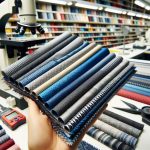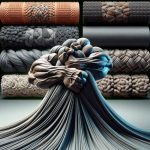Comparing synthetic and natural fibers is like contrasting two sides of a coin; each has its unique characteristics and impacts on the environment.
As we navigate through the endless aisles of clothing options, the choice between these fibers can significantly influence our planet's well-being.
The tale of Synthetic Vs. Natural Fibers is not merely about what we wear but extends to broader environmental implications that shape our world in unexpected ways.
Table of Contents
Key Takeaways
- Environmental impact favors natural fibers due to biodegradability and renewable sourcing.
- Durability leans towards synthetic fibers for longevity and strength.
- Strength varies, with synthetics excelling in tensile strength and shape retention.
- Affordability favors synthetic fibers due to efficient, cost-effective production processes.
Environmental Impact
When considering the environmental impact of fibers, it becomes evident that natural fibers like cotton and wool offer a more sustainable choice compared to synthetic counterparts. Natural fibers are biodegradable, meaning they break down easily in the environment, unlike synthetic fibers such as polyester and nylon, which can take centuries to decompose, contributing to pollution.
Cotton, a widely used natural fiber, does require significant water and land resources for production, impacting the environment. On the other hand, synthetic fibers like polyester are derived from fossil fuels and chemicals, further straining environmental resources. Overall, the environmental impact of natural fibers is generally lower due to their biodegradability and renewable sourcing compared to synthetic fibers.
Opting for natural fibers over synthetic ones can play a significant role in reducing the accumulation of non-biodegradable materials in landfills and oceans, making them a preferable choice for those looking to lessen their ecological footprint.
Durability and Longevity
When considering durability and longevity of fibers, it's crucial to acknowledge the strength of each material.
Synthetic fibers like polyester and nylon tend to outlast natural fibers due to their resistance to wear and tear.
Comparing the lifespan of synthetic and natural fibers sheds light on the practical aspects of choosing between the two for various uses.
Strength of Fibers
Synthetic fibers like polyester and nylon offer exceptional strength and durability, making them highly resistant to wear and tear. Polyester, known for its robustness, maintains its shape well and resists stretching and shrinking.
Nylon, on the other hand, boasts high tensile strength, making it incredibly durable and suitable for various applications. These synthetic fibers outshine natural options in longevity and damage resistance, especially in high-wear scenarios. While natural fibers like wool and silk also possess strength and durability, they may not match the endurance of synthetics.
Blending natural fibers with synthetics can enhance overall durability while maintaining comfort. Understanding the strength attributes of both synthetic and natural fibers is key to selecting the most suitable material for specific textile needs.
Wear and Tear
With a focus on durability and longevity, exploring the wear and tear differences between synthetic and natural fibers reveals essential insights into textile performance.
Synthetic fibers like polyester and nylon are renowned for their durability, resisting wear and tear with remarkable strength. They maintain their structural integrity even with frequent use, making them ideal for high-wear applications.
On the other hand, natural fibers such as cotton and wool are more prone to wear and tear, potentially leading to issues like shrinkage, stretching, and damage over time. Proper maintenance is crucial to extending the lifespan of natural fibers, unlike synthetics, which often require less upkeep.
Understanding these differences in durability and maintenance can help in making informed decisions about textile choices.
Lifespan Comparison
Exploring the lifespan comparison between synthetic and natural fibers sheds light on their durability and longevity, revealing distinct characteristics that impact textile performance.
- Synthetic fibers like polyester and nylon are renowned for their extended lifespan, often outlasting natural fibers such as cotton or silk due to their exceptional durability.
- Studies have demonstrated that synthetic fibers can retain their shape and color for a longer duration when compared to natural fibers, showcasing the longevity benefits of synthetic materials.
- The robust molecular structure of synthetic fibers plays a significant role in their longevity, contributing to their ability to resist fading, stretching, and tearing better than many natural fibers.
Understanding these differences can guide consumers in making informed decisions when selecting textiles based on their desired lifespan and durability requirements.
Breathability and Comfort
When it comes to breathability and comfort in fabrics, airflow plays a crucial role in keeping us cool and feeling good.
Natural fibers like cotton and linen are known for being skin-friendly materials that promote better air circulation, reducing the risk of sweat and odor.
On the other hand, synthetic fibers may not offer the same level of breathability, potentially leading to discomfort and skin irritations in humid conditions.
Airflow in Fabrics
Natural fibers like cotton and linen outperform synthetic fibers in breathability, enhancing airflow and overall comfort in fabrics. When considering airflow in fabrics, here are three key points to keep in mind:
- Breathability Factor: Natural fibers allow for better air circulation, preventing heat and moisture buildup, which can be uncomfortable.
- Temperature Regulation: The airflow in natural fabrics helps regulate body temperature by allowing heat to escape, keeping you cool in warm weather.
- Moisture Management: Fabrics like cotton wick away moisture from the body, maintaining a dry and comfortable feel throughout the day.
Understanding these aspects of airflow in fabrics can guide you towards selecting materials that prioritize comfort and breathability, especially in hot climates.
Skin-Friendly Materials
For those seeking skin-friendly materials that prioritize breathability and comfort, the choice between natural and synthetic fibers plays a crucial role in overall skin health.
Natural fibers such as cotton and linen are known for their breathability, allowing better air circulation which reduces the likelihood of skin irritation. These materials are gentle on the skin, making them ideal for individuals with sensitive skin or skin conditions.
In contrast, synthetic fibers like polyester and nylon tend to trap heat and moisture, leading to discomfort and potential skin issues. Opting for natural fibers can help maintain skin health by enabling the skin to breathe and remain comfortable throughout the day.
Prioritizing skin-friendly materials like natural fibers can enhance overall comfort and well-being.
Manufacturing Process
In the realm of fiber production, the process of creating synthetic fibers involves intricate chemical reactions using polymers like polyester, nylon, and acrylic. This manufacturing process differs significantly from the natural fiber production method.
Here are three key points to consider:
- Chemical Compounds: Synthetic fibers are derived from chemical compounds, which are manipulated through various processes to form the desired fiber. This involves a series of complex reactions that require careful control and precision to ensure the quality of the final product.
- Industrial Machinery: The manufacturing of synthetic fibers often requires specialized industrial machinery to facilitate the production process. These machines are designed to handle the specific requirements of working with chemical polymers and ensuring the fibers are produced efficiently and effectively.
- Quality Control: Due to the nature of the chemical processes involved, strict quality control measures are essential throughout the manufacturing process of synthetic fibers. Regular testing and monitoring are necessary to maintain consistency and ensure the fibers meet the required standards for strength, durability, and other properties.
Color Retention
When it comes to keeping colors vibrant in fabrics, synthetic fibers like polyester outshine natural fibers like cotton or wool. Synthetic fibers hold onto dye molecules more securely, extending the lifespan of bright hues in clothing.
On the contrary, natural fibers can experience quicker color fading due to their organic composition and porous nature.
Synthetic Color Durability
With superior color retention properties, synthetic fibers like polyester outshine natural fibers in maintaining vibrant hues wash after wash.
When it comes to synthetic color durability, there are a few key points to consider:
- Chemical Structure: Synthetic fibers have a chemical structure that allows them to hold dyes better than natural fibers, resulting in excellent color retention over time.
- Resistance to Fading: Polyester, a common synthetic fiber, is renowned for its resistance to fading, making it a popular choice for colorful clothing that needs to maintain its vibrancy.
- Ideal for Intense Colors: Synthetic fibers are often preferred for products requiring intense or bright colors due to their ability to retain color even with frequent washing and exposure to sunlight.
Natural Fiber Fading
Natural fibers, such as cotton and wool, can experience fading in color over time, particularly when exposed to sunlight and frequent washing. Cotton fibers are prone to losing color intensity faster than synthetic fibers when exposed to UV light.
Similarly, wool fibers can fade or change color if subjected to harsh washing methods or excessive heat. Additionally, natural dyes used in these fabrics may also contribute to color fading over time.
To slow down this process, it's essential to provide proper care and maintenance to your natural fiber garments. By following appropriate washing instructions, avoiding direct sunlight exposure, and using gentle detergents, you can help preserve the vibrant colors of your natural fiber clothing for longer periods.
Eco-Friendliness
Opting for natural fibers like cotton and wool instead of synthetic materials can significantly enhance the eco-friendliness of our clothing choices. When considering the environmental impact, here are three key reasons why natural fibers stand out:
- Biodegradability: Natural fibers are biodegradable, meaning they can easily decompose and return to the earth without causing harm. On the contrary, synthetic fibers like polyester and nylon aren't biodegradable and can linger in landfills for decades, contributing to pollution.
- Renewable Resources: Natural fibers are sourced from renewable resources such as plants and animals, making them a more sustainable choice. In contrast, synthetic fibers are often derived from fossil fuels, leading to a higher carbon footprint and environmental damage.
- Microplastic Pollution: Choosing natural fibers over synthetic ones can help reduce microplastic pollution. Synthetic materials shed tiny plastic particles when washed, which can end up in oceans and harm marine life. By opting for natural fibers, we can mitigate this environmental issue and promote a healthier planet.
Hypoallergenic Properties
Enhancing comfort and promoting skin health, hypoallergenic properties are a standout feature of natural fibers like cotton and silk. These fibers are gentle on the skin, making them ideal for individuals with sensitivities or allergies. The hypoallergenic nature of natural fibers reduces the risk of skin irritation and allergic reactions, providing a soothing experience for those prone to discomfort.
When compared to synthetic fibers like polyester and nylon, which may not possess hypoallergenic properties, natural fibers shine in their ability to care for sensitive skin. By choosing hypoallergenic natural fibers, such as wool and linen, individuals can prioritize both comfort and skin health, avoiding potential irritations that synthetic materials might cause.
For those seeking clothing or bedding that's gentle on the skin, opting for natural fibers with hypoallergenic properties is a wise choice. These materials not only feel luxurious but also contribute to a healthier, happier relationship with one's skin.
Dye Compatibility
When considering dye compatibility, it's important to acknowledge the distinct characteristics of synthetic and natural fibers.
- Specific Dyes for Synthetic Fibers: Synthetic fibers, due to their poor absorption capabilities, require specific dyes that can bond effectively with the material. These dyes are formulated to work efficiently with synthetic fibers, ensuring vibrant and long-lasting coloration.
- Color Options: Natural fibers may have a more limited range of color options compared to synthetic fibers. This can impact the dyeing process as certain shades may be harder to achieve with natural fibers, influencing the final look of the fabric.
- Dyeing Techniques: Different dyeing techniques are needed for natural and synthetic fibers based on their specific characteristics. Understanding these techniques is crucial to achieve optimal results when dyeing fabrics made from either synthetic or natural materials.
Being aware of these factors can help in selecting the right dyes and techniques to ensure successful and visually appealing outcomes when dyeing synthetic and natural fibers.
Absorbency and Moisture Management
Natural fibers, such as cotton, excel in absorbency and moisture management, offering superior comfort and sweat absorption properties compared to synthetic fibers like polyester. Cotton's ability to absorb moisture efficiently makes it a top choice for textiles where staying dry is essential. On the other hand, polyester, being a synthetic fiber, lacks in absorbency, leading to potential discomfort in humid or sweaty conditions. Let's compare the absorbency and moisture-wicking properties of these two types of fibers in the table below:
| Property | Cotton | Polyester |
|---|---|---|
| Absorbency | High; can absorb up to 27 times its weight in water | Low; tends to repel moisture |
| Moisture-wicking | Excellent at wicking away moisture, keeping you dry | Less effective in managing moisture |
The absorbency of natural fibers like cotton contributes to their breathability and overall comfort, making them a preferred choice for those seeking effective moisture management in their clothing.
Fiber Length and Structure
The diversity in fiber length and structure plays a crucial role in determining the quality and characteristics of textiles made from both natural and synthetic fibers.
- Fiber Length: Natural fibers like cotton exhibit a range of staple lengths, from short to long, influencing the fabric's quality and strength. In contrast, synthetic fibers are manufactured with uniform fiber lengths, ensuring consistent fabric properties.
- Structure: The structure of natural fibers, such as the twist and alignment of cotton fibers, significantly impacts the fabric's texture, drape, and strength. On the other hand, synthetic fibers like polyester have a controlled molecular structure, leading to predictable fabric characteristics and performance.
- Impact: Variations in fiber length and structure affect various aspects of fabric production, including processing, dyeing, and overall performance. Understanding these differences allows for tailored approaches to working with natural and synthetic fibers, optimizing the quality and functionality of the final textile products.
Affordability and Cost
Synthetic fibers offer a more cost-effective alternative to natural fibers due to their efficient production processes and use of inexpensive raw materials. Man-made textiles are generally more affordable because they're mass-produced using techniques that drive down manufacturing costs significantly. In contrast, natural fibers are often pricier due to the sourcing process from plants or animals, leading to higher production costs.
The multiple processing steps involved in turning natural fibers into textiles also contribute to their relatively higher price point. When considering affordability, synthetic fibers present a more budget-friendly option compared to natural fibers. This cost difference stems from the streamlined manufacturing of synthetic fibers, which benefits from the economies of scale achievable in large-scale production.
Thus, for those seeking quality textiles at a more accessible price point, synthetic fibers stand out as a compelling choice over their natural counterparts.
Impurities and Chemicals
Moving from discussing affordability to impurities and chemicals in fibers, it's essential to understand how these factors can impact the quality and characteristics of textiles.
- Impurities in Natural Fibers: Natural fibers, originating from plants or animals, may contain impurities such as dust particles. These impurities can affect the overall quality of the fabric and its dye absorption capabilities.
- Synthetic Fibers and Impurities: Unlike natural fibers, synthetic fibers are typically impurity-free, making them less prone to collecting dust. However, chemical processing during their production can introduce impurities that may affect the textile's characteristics.
- Chemical Processing Impact: Both natural and synthetic fibers undergo chemical processing during production. This processing can introduce impurities in the fibers, affecting their properties such as dye absorption and overall quality.
Understanding the presence of impurities and chemicals in fibers is crucial for selecting the right material for specific textile needs, ensuring the desired quality and characteristics are achieved.
Frequently Asked Questions
Why Are Synthetic Fibres Better Than Natural?
I find synthetic fibers better than natural ones because they are durable, resource-efficient, cost-effective, and versatile. They offer specific properties like moisture-wicking and color retention. Their production is controlled, leading to consistent quality and performance.
How Do You Tell if a Fiber Is Natural or Synthetic?
To tell if a fiber is natural or synthetic, I look for labels on my clothing items. Understanding the source and production process helps me differentiate between the two. It's crucial to know what I'm wearing!
What Are the Pros and Cons of Synthetic Fibers?
Pros of synthetic fibers include durability and wrinkle resistance, ideal for long-lasting clothing. They often cost less to produce and can mimic natural fibers. However, their environmental impact from non-renewable resources raises sustainability concerns.
Do Synthetic Fibers Burn Faster Than Natural Fibers?
Absolutely, synthetic fibers burn faster due to their chemical composition. The combustion process releases intense heat energy, causing quicker burning. Understanding these differences is vital for safety. Synthetic fibers can pose unique risks compared to natural fibers.
- Tetron Fabric for Marine Applications: Durability and Use Cases - June 18, 2025
- Tetron Fabric for Outdoor Furniture: Weather Resistance and Care - June 18, 2025
- Tetron Fabric for Wall Coverings: Style and Application Tips - June 18, 2025







